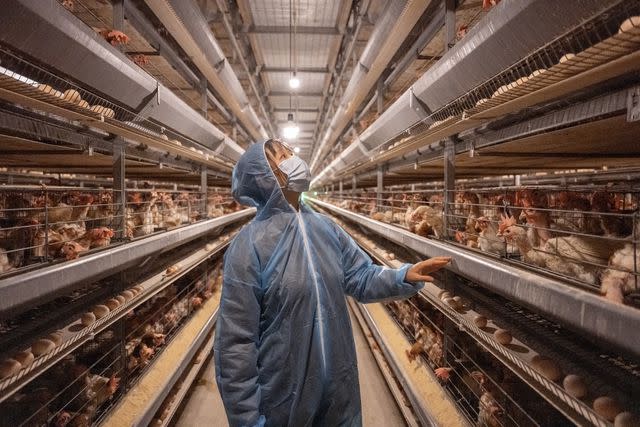Everything You Need to Know About Keeping Safe Amid the Bird Flu Outbreak
According to the CDC, human risk remains low.

Johner Images / Getty Images
Last week, a Texas dairy farm worker who had “exposure to dairy cattle” was confirmed to have tested positive for a “highly pathogenic” strain of avian influenza — also referred to as A(H5N1). According to the Centers for Disease Control and Prevention (CDC), this is the second-ever instance of H5N1 reported in the United States, although it is the first contracted from cattle. The previous case, which was reported in 2022, was of a Colorado inmate at a state correctional facility who was infected after processing infected birds while he was participating in a work program at a poultry farm.
The Texas patient suffered only mild symptoms — eye redness “consistent with conjunctivitis” — and is being treated with antiviral medication while in isolation. “This infection does not change the H5N1 bird flu human health risk assessment for the U.S. general public, which the CDC considers to be low. “However, people with close or prolonged, unprotected exposures to infected birds or other animals (including livestock), or to environments contaminated by infected birds or other animals, are at greater risk of infection.”
Avian influenza has officially been confirmed in the states of Idaho, Kansas, Michigan, New Mexico, and Texas. And goats in Minnesota have also tested positive.
And while there is no indication of person-to-person spread — or that anyone has contracted the diseases by way of milk, meat, or eggs — there’s an understandable concern among U.S. citizens about how to stay safe. Here’s everything you need to know about the current avian influenza outbreak.
What is the bird flu?
Bird flu is caused by an influenza virus that affects birds — both wild and domestic. The viruses are categorized as avian influenza A viruses and there are two main types, according to the CDC: Low Pathogenic Avian Influenza (LPAI) and Highly Pathogenic Avian Influenza (HPAI).
Related: Eating Like a Salmon Is Better Than Eating Actual Salmon, Study Finds
The former, which is more common, causes “either no signs of disease or mild disease in chickens/poultry (such as ruffled feathers and a drop in egg production).” But it can potentially mutate into highly pathogenic avian influenza viruses, given the right conditions. In contrast, the latter, is responsible for “severe diseases and high mortality” in poultry.
What are the symptoms of bird flu in humans and how is it contracted?
It’s uncommon for avian influenza to infect humans, but it happens. “Illness in humans from bird flu virus infections have ranged in severity from no symptoms or mild illness to severe disease that resulted in death,” per the CDC.
Humans contract the disease when the virus is inhaled — or gets into a person’s eyes, nose, or mouth. “Human infections with bird flu viruses have occurred most often after unprotected contact with infected birds or surfaces contaminated with bird flu viruses,” the CDC says. “This can happen when virus is in the air (in droplets or possibly dust) and a person breathes it in, or possibly when a person touches something that has virus on it then touches their mouth, eyes or nose.”
Related: Everything You Need to Know About Reheated Rice Syndrome
Symptoms include upper respiratory issues (such as cough, sore throat, or a stuffy nose), pneumonia, eye redness, headaches, fever, fatigue, muscle pain, diarrhea, nausea, seizures, vomiting, and shortness of breath. If you experience any of the above in relation to potential H5N1 exposure, call your primary care physician — in addition to your state or local health agency. You should be treated with antiviral medication.
Can bird flu spread between people?
The majority of avian influenza cases in humans are typically contracted through birds, and human-to-human transmission is incredibly rare. But it has happened in the past and is not unheard of. So it’s important to take precautions if you think you’ve been exposed.
Are milk, eggs, and dairy products safe to consume?
The Food and Drug Administration recently stated that it “does not currently have concerns” about pasteurized milk and cheese, given that the pasteurization process destroys pathogens through the heating of milk. Beyond that, milk from infected cows has either been “diverted or destroyed” — so you can feel safe in the assurance that none of the milk on supermarket shelves is contaminated.
As for raw or unpasteurized milk, there are still a lot of unknowns regarding transmission, but “Because of the limited information available about the possible transmission of HPAI A (H5N1) viruses in raw milk, the FDA recommends that industry does not manufacture or sell raw milk or raw milk cheese products made with milk from cows showing symptoms of illness, including those infected with avian influenza viruses or exposed to those infected with avian influenza viruses.”
Cal-Maine Foods, the largest supplier of eggs in the United States, had chickens that tested positive for H5N1. Does that mean that we should all be worrying? No — but it’s best to be cautious. Infected hens will likely lay contaminated eggs, and because most eggs sold in cartons aren’t pasteurized, it’s important to cook your omelets all the way through in accordance with U.S. Department of Agriculture’s Food Safety and Inspection Service time-temperature guidelines. Dough and other food items that may contain raw eggs should be avoided at this time. It should also be noted that there are strict industry controls in place that aim to prevent infected eggs from making their way to the U.S. market.
Related: Here Are the 12 Most Contaminated Fruits and Vegetables, Ranked
In terms of meat, the USDA remains “confident that the meat supply is safe.” Just make sure to use standard precautionary measures when handling raw products: Wash your hands frequently, don’t leave cooked food at room temperature for longer than two hours, and use a food thermometer.
Should I be concerned about my pets?
Avian influenza typically affects wild birds such as ducks, geese, chicken, and turkeys. Commercial poultry are also vulnerable. But it’s important to note that not only wild or barnyard animals are susceptible. Backyard flocks, as well as pet birds that may come in contact with infected wildfowl, could contract the disease. As for cats and dogs, they could get bird flu if they consume or are around sick animals.
“If your domestic animals go outside and could potentially eat or be exposed to sick or dead birds infected with bird flu viruses, or an environment contaminated with bird flu virus, they could become infected with bird flu,” the CDC said in a statement. “While it’s unlikely that you would get sick with bird flu through direct contact with your infected pet, it is possible. For example, in 2016, the spread of bird flu from a cat to a person was reported in NYC.”

tianyu wu / Getty Images
There's no indication of person-to-person spread, but it's important to remain vigilant and follow precautionary measures.I have a pet bird, now what?
Pet birds, like any other pet you may have, should be moved indoors and kept away from potential exposure to wild birds or rodents. If your pet bird shows symptoms of avian flu — such as diarrhea, reduced egg count, lack of coordination, or nasal discharge — you should monitor your own health and watch out for signs of infection. And if you find a dead bird elsewhere, get in touch with your state wildlife agency, state veterinary diagnostic lab, or state health department. As for backyard flocks, the American Veterinary Medical Association has these guidelines, which are simple enough to follow.
For more Food & Wine news, make sure to sign up for our newsletter!
Read the original article on Food & Wine.

